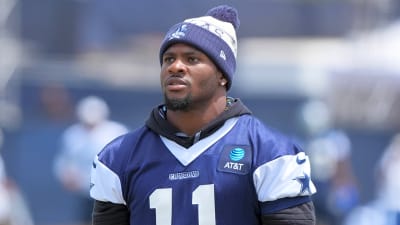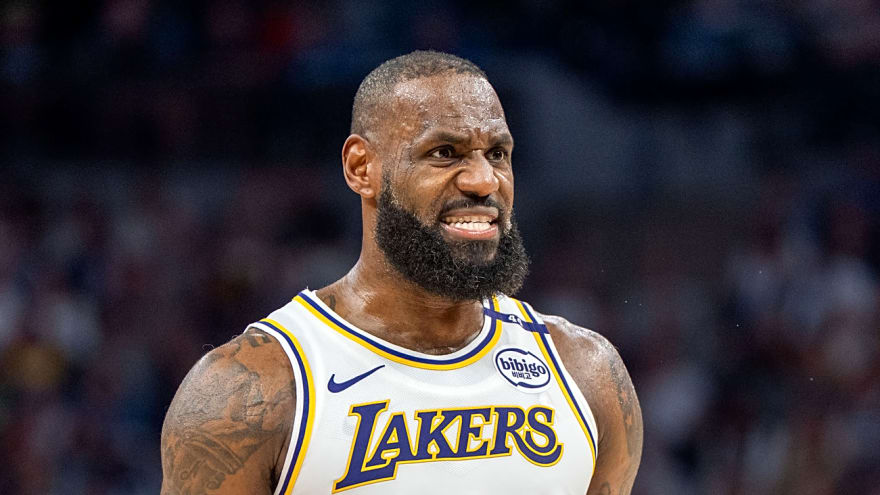
How Browns reportedly could 'appeal' to Falcons' Kirk Cousins
Atlanta Falcons quarterback Kirk Cousins is spending the spring waiting to either be released or get traded to a team in need of a 2025 Week 1 starter such as the Cleveland Browns.
Meanwhile, Tony Grossi of ESPN Cleveland/The Land on Demand suggested as recently as this week that the Browns could take either Colorado wide receiver/cornerback Travis Hunter or Penn State pass-rusher Abdul Carter instead of Colorado signal-caller Shedeur Sanders with the second overall pick of the 2025 NFL Draft.
For a piece published Wednesday morning, NFL insider Albert Breer of Sports Illustrated explained how the Browns' handling of the draft could impact their potential pursuit of Cousins.
"I do think if the Browns decide to take Carter with the second pick," Breer wrote, "then Cousins would appeal to them, given the relationship the quarterback has with (Browns head coach) Kevin Stefanski from Minnesota. It would be, in my mind, a nice fit for everyone and allow Cleveland more flexibility on taking a quarterback in the draft. Cousins is amenable to teams working out trade terms on a contingency ahead of the draft, so maybe that’s how this one plays out over the coming weeks."
It was previously reported that Cousins, who has a full no-trade clause attached to his contract, does not want a team interested in acquiring him to take a quarterback in the first round of the 2025 draft. Atlanta famously signed Cousins in March 2024 but then made Michael Penix Jr. the eighth overall pick of last year's player selection process.
Cousins had Stefanski as a quarterbacks coach and offensive coordinator when they were with the Vikings. The 36-year-old lost the Atlanta starting job to Penix this past December.
In his latest mock draft, Grossi predicted that the Browns will grab Alabama quarterback Jalen Milroe at overall choice No. 33. Milroe played under Browns offensive coordinator Tommy Rees in college.
With that said, Browns reporter Mary Kay Cabot of the Cleveland Plain Dealer shared on Tuesday that Cleveland is searching for a rookie quarterback who can "lead the team and serve as the face of the franchise." That update indicates that taking Sanders at No. 2 is at least on the table for the Browns.
The Tennessee Titans are reportedly on track to make Miami quarterback Cam Ward the top pick of the draft. Neither the New York Giants nor the Pittsburgh Steelers seem likely to trade for Cousins anytime soon.
In the end, Cousins may have to tolerate sharing a locker room with Sanders to enter training camp as an NFL QB1 this summer.
More must-reads:
- Falcons' Kirk Cousins reportedly could have trade demand for interested teams
- Falcons insider predicts how Kirk Cousins saga will end
- The 'Most passing yards in an NFL game' quiz
Breaking News
Trending News
TODAY'S BEST

Justin Fields Called 'Biggest Loser' In Jets Training Camp
The New York Jets opted to cut Aaron Rodgers and sign Justin Fields to replace him during the offseason. This kind of commitment to Fields should bolster his confidence, but it could also place a lot of pressure on his shoulders. To this point, Fields has looked solid in training camp, aside from a scary toe injury that was quickly resolved in July. Justin Fried of the Jet Press recently reported that Fields' training camp may have reached a new low over the weekend as the young signal caller struggled. "Justin Fields put together his best practice of the summer to this point on Friday, completing his first 12 passes en route to an excellent all-around performance. The same can't be said about his showing on Saturday, however," Fried wrote. "Fields finished the day an abysmal 2-of-10 in the air, including a drop from rookie tight end Mason Taylor. "Some of his incompletions were catchable balls, but the Jets' passing game struggles on Saturday can largely be blamed on No. 7. Fields did flash his running ability with a 25-yard rushing score on the first play of red-zone drills, but the Jets would like to see more consistency in the air from the starting quarterback. Saturday's scrimmage was far from his best showing of the summer." Fields is a runner first at the NFL level, but his arm is nothing to scoff at. For most of training camp, his arm talent has been better than advertised, but during Saturday's scrimmage, it just wasn't there. A 2 for 10 performance is unacceptable for a $40 million quarterback who was signed to take over the team. The running game should open up the passing game for the Jets, which is going to need to be the case if Fields is going to struggle like this. However, it's just one day of camp. It's nothing to be too concerned about. Just because Fields lost this specific practice doesn't mean he's heading in the wrong direction as a whole.

Yankees Catcher In Danger of Losing Job
There's plenty of blame to go around for the New York Yankees' free fall over the past two months, but the struggles of the club's starting catcher have seemingly flown a bit under the radar. Austin Wells came into the season with some rather high expectations placed upon him following a fruitful rookie campaign in 2024, during which he appeared in 115 games. Over that stretch, the left-handed hitter slashed .229/.322/.395 with 13 home runs, 55 RBIs and a 106 wRC+ while posting 12 Framing Runs, per Baseball Savant, which ranked in the 96th percentile. While Wells never found his footing amidst the Yankees' run to the World Series last fall, batting .120/.200/.260 in the playoffs, he finished third in AL Rookie of the Year voting and looked to be blossoming into a potential star behind the plate. The 26-year-old got off to a fast start in 2025, slashing .224/.288/.464 with 11 homers, 43 RBIs and 1.9 fWAR through June 15, but his performance has fallen off a cliff ever since. From June 16 through August 3, Wells has hit .180/.227/.330 in 110 plate appearances. His 51 wRC+ and .557 OPS both rank as the second-worst marks among catchers with at least 100 trips to the plate over that span. While Wells remains a stout defender, evidenced by his eight Framing Runs and four Blocks Above Average this season, he's providing next to nothing offensively. He's recorded a hit in just three of his last 10 games, dropping his season-long OPS to .687, and he hasn't logged multiple hits in a single contest since July 9. Wells made an inexcusable mistake on the base paths during the Yankees' bout with the Tampa Bay Rays on July 30 as well, advancing to second base on a bunt in the ninth inning before forgetting there were two outs instead of three and getting tagged out to send the game to extras. While New York emerged victorious in that contest, it was still an embarrassing moment that further accentuated Wells' recent shortcomings. As Ben Rice receives more opportunities behind the plate after J.C. Escarra was optioned to Triple-A Scranton/Wilkes-Barre, Wells is suddenly in danger of losing his starting job. He still has the leg up due to his defensive prowess and ability to call games, but his margin for error is thinning by the second. Make sure to bookmark Yankees On SI to get all your daily New York Yankees news, interviews, breakdowns and more! Aaron Boone Responds to Yankees Legends' Criticism Yankees Manager Gets Brutally Honest After Historic Loss Yankees Make Awful MLB History Against Marlins Luis Gil Makes First Yankees Debut Since Injury Yankees Legends Slam Team for Struggles

Matt LaFleur sheds light on concerning Tucker Kraft situation
The Green Bay Packers continued work on the field on Saturday, with tens of thousands of fans in attendance watching amid the annual Family Night. However, one notable player who was not able to make it to the field and practice was tight end Tucker Kraft. The former South Dakota State Jackrabbits star is nursing a lower-body injury, forcing the Packers to take it easy on the tight end and keep him on the shelf rather than risk aggravation of the issue. Speaking to the media, Packers head coach Matt LaFleur opened up about Kraft’s status, via Green Bay reporter Rob Demovsky of ESPN. “MLF said Tucker Kraft has been dealing with a groin injury and powering through it for the last two days but they decided to give him a couple days off.” Kraft is expected to be among the major targets in the Packers’ passing attack in his third year in the pros. Selected in the third round (78th overall) by the Packers in the 2023 NFL draft, the 24-year-old Kraft is looking to surpass his production in 2024, when he posted 707 receiving yards and seven touchdowns on 50 receptions.

Zero RB Strategy Explained: Top Fantasy Football Targets for 2025
If you’ve participated in fantasy football for a few years, chances are you’ve heard discussions about “Zero RB.” But what does the zero running back strategy actually mean, and how might it benefit fantasy managers on draft day? The following is a comprehensive look at the Zero RB approach, as well as players suited to this draft philosophy whom you can consider targeting for the upcoming season. Don't forget to sign up for your fantasy football league on Yahoo Sports! What is Zero RB Strategy? Although its name suggests otherwise, the Zero RB strategy doesn’t require fantasy football managers to entirely disregard the running back position during drafts or leave those roster spots empty. Typically, the Zero RB approach involves focusing on other positions in the early rounds, building a strong group of wide receivers and locking in top options at quarterback and/or tight end. While opinions differ on the exact round where Zero RB draws the line, the strategy generally means waiting until at least the fifth round or beyond to select your first running back. Running back is one of the most unpredictable positions throughout the season, largely due to injuries. Backup players often step into starting roles and deliver significant fantasy production, no matter their perceived talent. By spending minimal draft capital on premium running backs and instead targeting late-round options with breakout potential, the Zero RB strategy aims to capitalize on this volatility. Use promo code YARD20 for $20 off your FantasyLabs fantasy football subscription! Pros of Zero RB Strategy There are several appealing advantages to the Zero RB strategy, making it especially popular among bold fantasy football drafters. One clear benefit is the opportunity to build greater strength at other positions when running backs are bypassed early. This approach lets fantasy managers more easily prioritize the single starting spots at quarterback and tight end. Instead of struggling to fit high-upside players like Brock Bowers in the second round or elite quarterbacks such as Lamar Jackson, Josh Allen, or Jalen Hurts into your early draft plan, the Zero RB method actually encourages you to target these difference-makers. The positional edge provided by top quarterbacks and tight ends is tempting, but many fantasy players hesitate to spend early draft capital on them. Zero RB, however, expands your flexibility and allows you to load up on these potential game-changers. Injuries are another key factor in favor of this strategy. Running backs are more prone to injuries than most other positions. Every season, several first-round backs land on injured reserve, sinking their fantasy managers’ title hopes along the way. Even elite talents like Christian McCaffrey have endured significant mid-season injuries in multiple years. Zero RB aims to avoid the risk of early picks being wasted on running backs and instead focuses on investing in positions with fewer injury risks. The strategy also aims to take advantage of the inherent volatility at running back—when injuries happen, backups often step into sizable workloads, which rarely occurs at wide receiver. Late-round backs can produce major fantasy value, and with enough lottery ticket picks, you could land on a league-winning player at a bargain. For example, last year Chase Brown emerged from a crowded backfield in Cincinnati to deliver a top-10 PPR season. Of course, there are drawbacks. For starters, you’ll need those late-round running backs to outperform expectations to have a real shot at a fantasy championship. Relying on backups and timeshare players fills your bench with potential options—or weekly headaches as you try to decide who to start. Often, a Zero RB draft means your week one running backs look weak on paper. That’s part of the plan: you hope your other positions are stacked and that, as injuries strike, you’ll be able to improve your running back situation. The greatest risk may come if your top quarterback or tight end suffers a major injury. Since Zero RB teams use early picks to secure stars at these positions rather than focusing on depth, losing one can be devastating—especially if your late-round running backs can’t pick up the slack. With this approach, your path to victory relies on both health for your top picks and luck in finding running back breakouts as the season unfolds. Dominate your Best Ball and season-long fantasy football leagues with FantasyLabs’ brand-new app that's available in the Apple App Store and on Android! Cons of Zero RB Strategy For a strict Zero RB approach, many fantasy managers recommend holding off until at least the fifth round before selecting your first running back. Of course, there isn’t a fantasy football overlord who will punish you for choosing someone like Kenneth Walker III in the third or fourth round. Ultimately, the smartest draft strategy is to capitalize on whatever value is available during your draft. If an outstanding running back falls into the early rounds, it’s perfectly reasonable to abandon the Zero RB philosophy. However, for those committed to following the strategy no matter what, the usual guidance is to build out your starting wide receivers, quarterback, and tight end before targeting a running back. Top Zero RB Targets in 2025 By the fifth or sixth round, there are still several starting running backs on the board who can offer steady production, even if they aren’t likely to deliver elite numbers. Here are some mid-round options to consider as potential RB1s when using a Zero RB strategy: Isiah Pacheco, RB, Kansas City Chiefs Returning from an injury-filled 2024, Isiah Pacheco enters this season healthy and looks significantly undervalued as a sixth-round pick in fantasy drafts, considering the upside he’s shown during his career. After being chosen in the seventh round of the NFL draft, Pacheco finished 15th in PPR scoring in 2023 and appeared poised for a breakout campaign last year before injuries struck. He’s in a strong position to outpace backfield competitors Kareem Hunt and Elijah Mitchell. Kaleb Johnson, RB, Pittsburgh Steelers Rookie running backs are appealing Zero RB selections in the mid-rounds thanks to their potential for a wide variety of outcomes. Former Iowa back Kaleb Johnson is expected to step right into the early-down role left open by Najee Harris and has a chance to challenge Jaylen Warren for more involvement in the passing game. Best Ball rankings from some of the top industry experts are also available on FantasyLabs. Late Round RB Targets in 2025 Keep in mind, the objective is to fill your bench with high-upside running backs in the later rounds of the draft. Here are several late-round fliers who could develop into weekly RB1 options as the season progresses: Cam Skattebo, RB, New York Giants Yet another rookie back with significant upside, Cam Skattebo has earned rave reviews out of Giants training camp. The Arizona State alum was known for his ability to punch in touchdowns near the goal line in college and seems likely to step into valuable scoring situations right away. If Skattebo can also contribute as a receiver, he has the potential to be an outstanding late-round find. While Tyrone Tracy Jr. and Devin Singletary have both shown flashes during their careers, neither should deter fantasy managers from taking a chance on Skattebo. Jordan Mason, RB, Minnesota Vikings Jordan Mason, once a backup for the 49ers, could see improved touches now that he’s with Minnesota. While Aaron Jones currently leads the Vikings’ backfield, Mason stands to claim a larger role, especially with Jones Sr. now 30 years old. Minnesota bolstered their offensive line in the offseason and is expected to rely more on the ground game as rookie J.J. McCarthy steps in as starting quarterback. Should Jones miss time, Mason would have the chance to break out as a top fantasy running back.
Customize Your Newsletter
 +
+
Get the latest news and rumors, customized to your favorite sports and teams. Emailed daily. Always free!






























